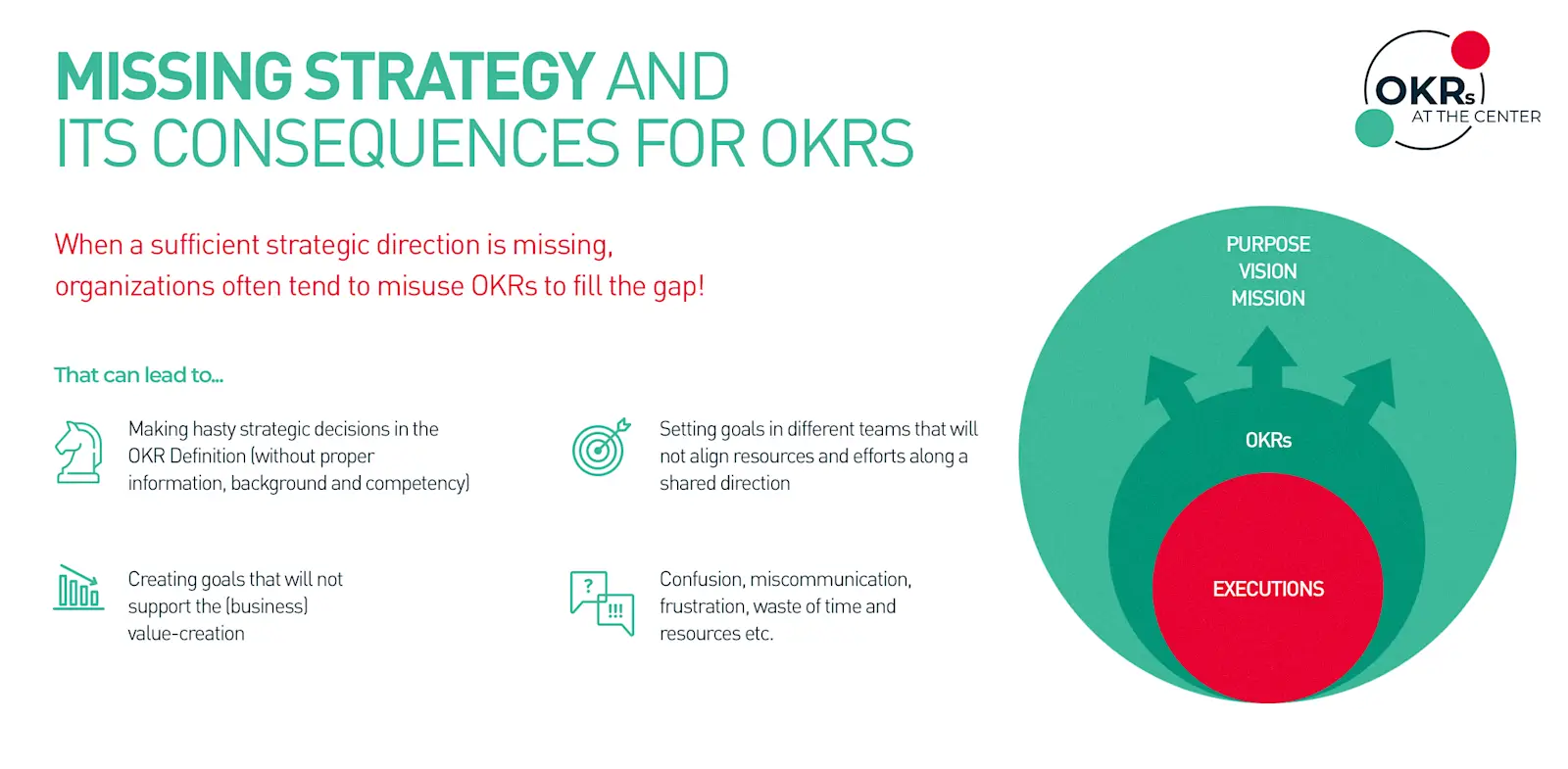Summary
Discover the crucial role of Objectives and Key Results (OKRs) in shaping your strategic planning. From goal setting to implementation, this article explores how OKRs connect strategy to action, creating a more effective process for achieving your organization’s Objectives.
You have a strategic plan. You’ve got buy-in. Congrats! Now, how do you execute it? This is where Objectives and Key Results (OKRs) come in. OKRs can help create the necessary guidelines and milestones to ensure you turn strategy into action — at every level of the organization. Let’s break down how they help and how to approach each aspect of the strategic planning cycle.
What is strategic planning?
You have a vision for your organization’s growth. But how will you get there? That’s where a strategic plan comes into play. Typically focused on building out your 3-5-year outlook, a strategic plan is a living, breathing document that clearly maps out what you need to do to deliver on those goals. Your strategic plan should reflect your company’s mission, vision, and include your short- and long-term goals, your action plan, budget, and perhaps most importantly, how you’ll meet and measure your goals.
The five steps of the strategic planning process
Before you start building your strategic plan, you need to know who’s responsible. A small, core group of stakeholders should be tasked with making the decisions and executing on the plan. Once you have the team in place, it’s time to get to work.
-
Determine your position: Assess where you are by reviewing your company’s mission, vision and values, as well as important financial and success benchmarks.
-
Analyze: Now that you’ve level set, it’s time to collect data. Whether you interview the executives in your organization, gather customer insights, run a SWOT analysis, or all of the above, figure out what your organization’s strengths and weaknesses are relative to turning your vision into reality.
-
Design a strategy: There are many ways to accomplish a vision. Choosing which paths to pursue (and when) is your strategy. Will you grow by expanding in the same market or by venturing into a new one? Both could be successful, but your strategy affects how your organization will make decisions. Based on the information you’ve gathered, determine which set of approaches align best with your mission and vision. This is the time to ask the hard questions such as:
- What do you need to succeed?
- What factors have the greatest impact on success?
- What challenges are the most pressing to overcome?
-
Implement strategy: Now, build out your plan of attack. Keeping in mind what needs to happen in 3-5 years, organize priorities based on your analysis above. Start with Objectives for year one (you can flesh out the following years later on), assign or determine a budget (do you need to spend, cut, hire?), and create a roadmap for each piece and potentially each quarter. OKRs will be a huge help in this phase (more on that below).
-
Monitor strategy: Because you’re playing a long game here — but have milestones and benchmarks to hit along the way — you’ll need to monitor progress. It goes without saying that this plan should be shared with anyone who will be part of helping carry it out. Determine how often you’ll have check-ins to assess progress and see if any tweaks need to be made. Since this is a living document, don’t get hung up on things that should be revised to meet the larger goal.
How does a strategic plan differ from other processes?
Strategic planning is in a category all its own because it sets you up to create a roadmap for how to achieve long-term goals. Some other processes you might be familiar with are:
- Vision and mission statements: Establish a high level idea of what an organization stands for and wants to achieve
- Business Plans: More granular and includes goals, financial objectives, operations, marketing and more
- Project Plans: Focuses on specific individual projects and its related tasks and deadlines
- Annual Plans (aka Operational Plan): Outlines the day-to-day steps an organization needs to take at each level (project, department, function, etc.) to achieve the strategic plan
How do OKRs fit into the strategic planning process?
“Strategy isn’t a plan to be executed, but a hypothesis to be continuously tested and validated,” says Dan Montgomery, an OKR consultant from Agile Strategies. Some people associate strategic planning with a months-long process that gets unveiled at an all staff meeting, but the planning part is just the statement of theory. Now, you need to decide which parts to act on, and you need to know whether or not the strategy is working. Enter OKRs.
-
As soon as you have your strategic plan, it’s time to determine an annual North Star organizational-wide OKR. This North Star OKR is meant to capture what your organization is trying to accomplish in the year ahead and what long-term success for the organization looks like. By creating a North Star OKR, you’ll be able to translate this big idea into actionable goals with shorter-term OKRs being guided by this North Star.
-
Once your North Star and shorter-term OKRs are established, announce them to the organization to create transparency and drive buy-in. Then teams can kick off the cascade and ladder phase for the next quarter (or whatever cadence works best for you). Cascading is how goals flow down from the top of an organization, while laddering is how goals work their way up, from bottom to the top.
Not every team inherits a Key Result (via cascading), but when top-level OKRs are communicated across an organization, every layer gets to work immediately on crafting their own OKRs based on the priorities they see in the top level OKRs. That’s why it’s called laddering. For OKRs to work, you need an empowered and motivated organization. Laddering is the result of a team being inspired by the OKRs set by another layer of the organization.
-
One of the reasons OKRs work well is because of regular check-ins. Once your OKRs are finalized, establish regular meetings to assess progress and validate if the strategy is working, or if you need to adjust either the strategy or your OKRs. We recommend brief weekly check-ins, and not going longer than a month. Then, based on what you learn from your reflections at the end of a cycle, kickoff the cascade and ladder of OKRs for the next cycle.
What are common mistakes when using OKRs in strategic planning?
- Confusing strategy, OKRs and tactics: Strategies are directional and a hypothesis about where we need to go. Tactics are the specific plans, actions, and steps that lead to the strategy. OKRs help to bridge the two. They articulate a strategy into goals to be achieved that then drive tactical plans.
- Using OKRs to substitute for strategy: OKRs are the highest priorities to execute and align on, while strategy represents everything you intend to do to achieve the mission. In other words, OKRs are an expression of the strategy, helping you reach your goals, but they aren’t the strategy itself. The below diagram illustrates what can happen when you try and use OKRs before defining a clear strategy.

Image credit: Natalija Hellesoe / OKRs AT THE CENTER
-
Writing OKRs for each cycle at the beginning of the year: OKRs shouldn’t be written more than one cycle ahead. This gives you the flexibility to improve as you learn from weekly tracking meetings. Were your KRs measuring the right things? Did you set the bar high enough, or too high? Is this still the most important thing to achieve?
-
OKRs don’t change often enough: Strategic planning tends to be multi-year, but we recommend topline OKRs to be written for one year, with next layers changing every quarter (based on progress, assessment and alignment with goals).
-
Tracking OKRs doesn’t affect strategy: If you’re falling behind on an OKR, it’s an early signal that the strategy isn’t working. Does the strategy need adjusting, or does the team need to organize differently?
When Rick Klau, formerly of Google Ventures, left Big Tech for a role in California state government, he brought OKRs to the new team. One crucial conversation surfaced a big misunderstanding. OKRs helped the leaders get buy-in from the team and instilled the confidence to take bigger swings. “Without that framework, the conversation just becomes horse-trading.” The team identified the most important tasks, shifted priorities in service of their common goal, and course-corrected to keep their OKRs on schedule.
-
You have an OKR for everything you do: OKRs are designed to be aspirational and inspire meaningful change within the organization. They aren’t just a way to track the routine things that comprise your overall job description — what we call business as usual (BAU). OKRs represent the next most important priority for change in this cycle.
Examples of combining OKRs with Strategic Planning
Now that you have your strategic plan, and corresponding OKRs, how do you execute on it? Here are two real-world examples:
Pinterest was an early adopter of OKRs. According to Naveen Gavini, Pinterest’s Head of Product, “While our mission has remained consistent over the years; our strategy, objectives, and key results evolve.” They write and track their OKRs in line with their operating cadence and have designed a Pyramid structure to visually demonstrate — and strengthen — the connection between their mission and longer-term strategy with the individuals on the ground.

Each department sets their OKRs based on the company Objectives, and teams and individuals ladder up from there. Incorporating OKRs at every level of the organization allows individuals to understand how their individual contribution and their team impacts the company as a whole.
Ariadne Labs, a health innovations lab at Brigham Women’s Hospital and Harvard T.H. Chan School of Public Health, aligns their strategic planning process with the university’s fiscal calendar. Strategy and annual North Star OKRs are set on the same deadlines, and then broken into shorter cycles throughout the year.
Conclusion
OKRs are the perfect tool to help your organization create the necessary guidelines and milestones to take your strategic planning process and make it actionable. If you want to learn more about using OKRs in strategic planning, take our OKRs 101 course or sign up for our Audacious newsletter.
